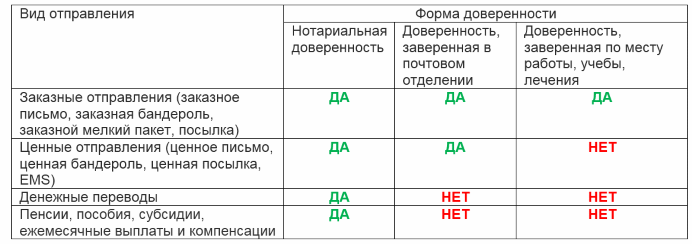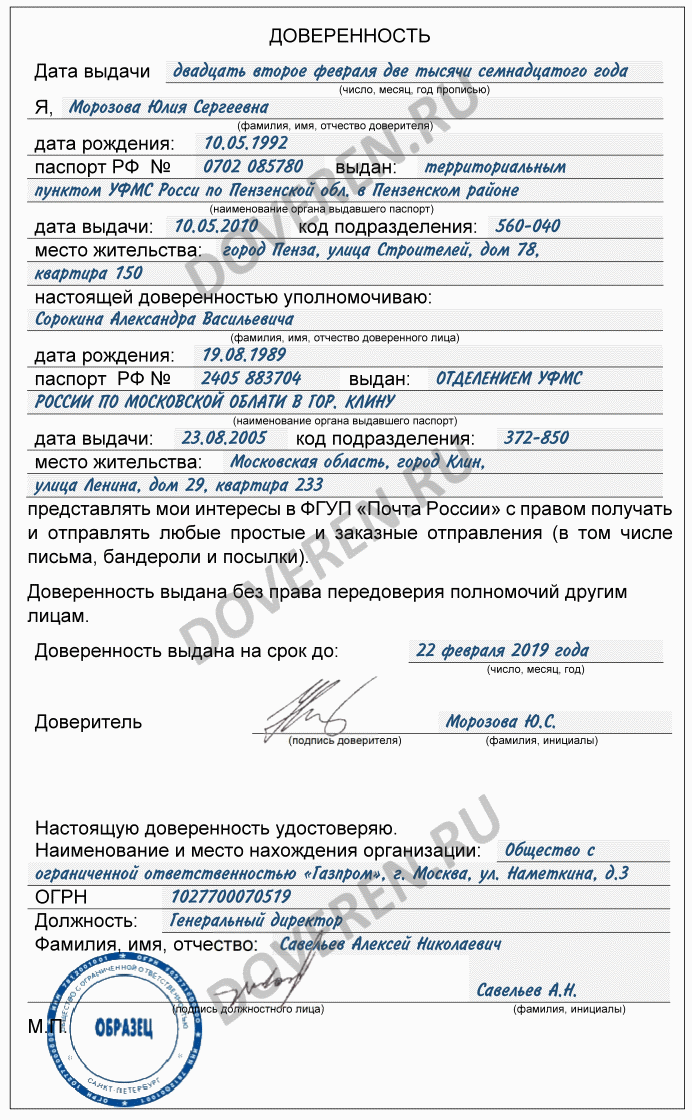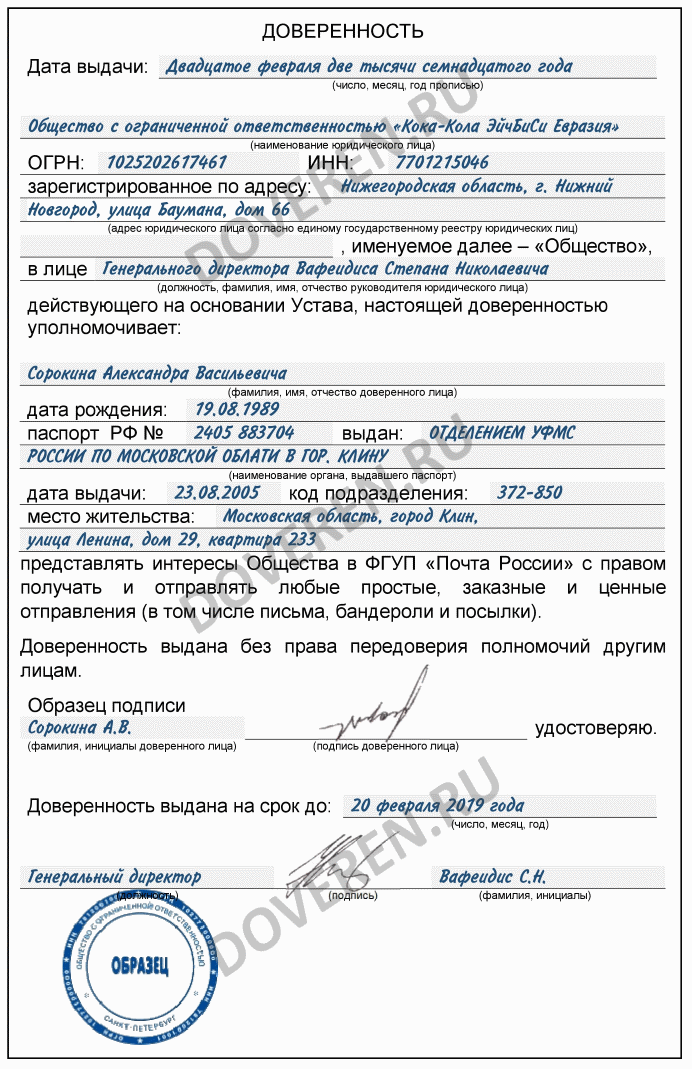Сейчас многие получают посылки, бандероли и письма (отправления) в отделениях Почты России (официальное наименование ФГУП «Почта России»). Согласно почтовым правилам корреспонденцию вправе забрать только тот человек на чье имя она адресована (адресат) или его представитель. Право получить любое регистрируемое отправление (то есть с трек-номером) можно поручить другому человеку если выдать ему доверенность на получение на почте России.
Давайте сначала разберемся, почему другой человек не может получить корреспонденцию без письменного подтверждения полномочий. Выдача отправления постороннему лицу является грубым нарушением почтовых правил, а работник связи, допустивший такое нарушение, может быть серьезно наказан и оштрафован. Передача письма постороннему человеку приведет к раскрытию тайны переписки, а выдача посылки приведет к имущественному ущербу. Поэтому в отделениях связи действуют требования выдачи отправлений «не адресатам» исключительно после проверки полномочий. Правило о необходимости проверки документа с полномочиями относится, в том числе к супругам и близким родственникам, проживающим совместно с получателем.
Правила выдачи отправлений
Почта доставляет разные отправления и для каждого из них существуют определенные требования к доверенности:
- Простые отправления (письма, простые бандероли, открытки) не имеют трек-номера и доставляются в почтовый ящик получателя. Для получения таких отправлений документа с полномочиями не требуется.
- Заказные отправления (заказные письма, заказные бандероли) имеют уникальный трек-номер. Они получаются лично адресатом или его уполномоченным лицом. Получить заказную корреспонденцию можно по доверенности, заверенной сотрудником почты или заверенной по месту работы, учебы или лечения, или удостоверенной нотариусом.
- Ценные отправления (ценные письма, ценные посылки и бандероли с объявленной ценностью) так же имеют трек-номер. Они вручаются лично получателю или его представителю. Ценную корреспонденцию можно забрать по доверенности, заверенной в отделении связи или удостоверенной нотариусом.
- Денежные переводы, пособия, субсидии, пенсии, ежемесячные выплаты и компенсации за адресата вправе получить только представитель по доверенности, оформленной у нотариуса.
Для удобства восприятия, информация о возможности получения различных видов отправлений по разным формам доверенностей сведена в таблицу:

Правила оформления и заверения доверенностей
Давайте более подробно рассмотрим как сделать доверенность на получение почты:
- нотариально удостоверенная доверенность. Может содержать максимально возможные полномочия на получение любых писем, посылок и денежных средств. Для оформления доверителю необходимо обращаться к нотариусу со своим паспортом и паспортными данными доверенного лица. Нотариус самостоятельно подготовит проект документа на основании данных, полученных от доверителя. За услуги по оформлению нотариус возьмет плату.
- доверенность, заверенная в почтовом отделении. Позволяет получать любые отправления, кроме денег. Можно составить такой документ самостоятельно в простой форме (подробное руководство здесь) на основе образца заполнения. После заполнения бланка нужно будет подойти с ним на почту и попросить сотрудника заверить его. При себе необходимо иметь паспорт. Возможность заверения доверенности непосредственно в отделении почты предусмотрена Рабочей инструкцией, которая является внутренним документом Почты России. Эта услуга предоставляется бесплатно. В таком порядке можно оформить доверенность на получение посылки на почте из Китая с сайта алиэкспресс (ru.aliexpress.com).
Образец заполнения:

При обращении гражданина с просьбой заверить доверенность, сотрудник почтамта должен действовать в следующем порядке. До начала оказания услуг по заверению, начальник (или заместитель) почтового отделения проверяет паспорт доверителя. После этого совершает следующие действия: проверяет правильность заполнения формы документа, делает на доверенности надпись «В личности удостоверился», вписывает свою должность, фамилию, имя и отчество, расписывается и ставит оттиск календарного штемпеля отделения почтовой связи. При обращении с такой доверенность в отделение, в котором оно было оформлено, доверенное лицо может получать все без исключения почтовые отправления (кроме пенсий и переводов денег).
- доверенность на получение почты, заверенная организацией в которой доверитель работает, учится или находится на лечении. Для оформления такого документа работник может обратиться к своему работодателю, студент может обратиться к администрации учебного учреждения, а пациент, находящийся на стационарном лечении вправе обратиться к администрации лечебного учреждения (больницы). Доверенность составляется в простой форме (инструкция по оформлению здесь), после чего передается руководителю организации, для заверения подписи. Учитывая, что попасть к руководителю организации на личный прием может быть не просто, целесообразно сначала обратиться с подготовленным проектом к юристу организации с просьбой заверить его в порядке предусмотренном пунктом 3 статьи 185.1. Гражданского кодекса РФ. Юрист расскажет, как подписать документ у руководителя организации и поможет соблюсти внутренние правила организации. Услуга по заверению должна предоставляться бесплатно.
Образец оформления:

Скачать бланк в формате MS Word
Доверенность на получение посылки на почте либо письма может быть выдана на любой срок. Если требуется заверение, то нужно быть готовым, что доверителю придется подписывать документ в присутствии должностного лица (руководителя работодателя, учебного или лечебного учреждения, нотариуса, сотрудника почты).
Непосредственно в отделении представителю потребуется предъявить свой паспорт и доверенность на получение посылки на почте или другого вида отправления. Законодательство не обязывает оставлять оригинал или копию доверенности в организации связи, но сотрудники часто предъявляют такое требование. Поэтому для того чтобы сэкономить свое время и нервы, лучше иметь при себе копию.
Доверенность на получение почты от юридического лица
Доверенность от организации может быть составлена в обычной форме и не требует заверения. Такой документ подписывается руководителем организации адресата и может быть выдан любому совершеннолетнему гражданину, даже если он не является сотрудником компании. Полномочия могут быть предоставлены одному или нескольким представителям. По такому документу можно получать любую корреспонденцию и посылки поступающие в адрес организации получателя. На подписанном бланке рекомендуется поставить печать организации. Правила оформления детально описаны в этой статье.

Комментарии
Страницы
Добавить комментарий